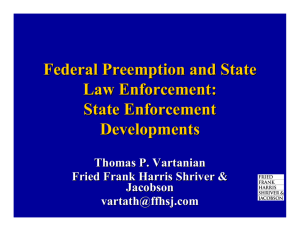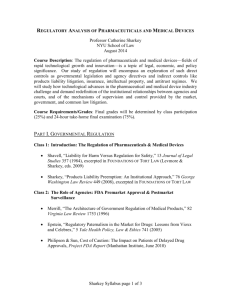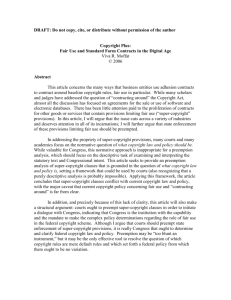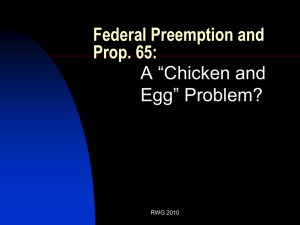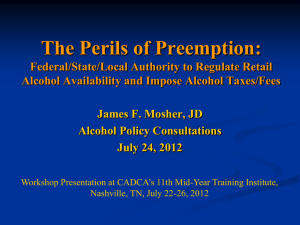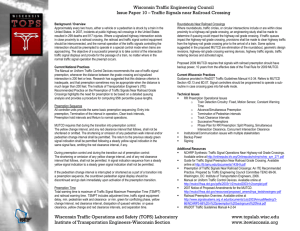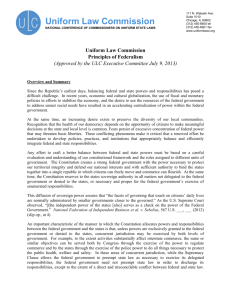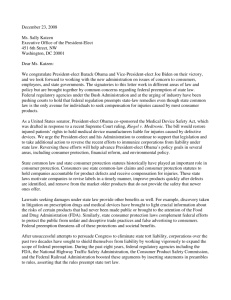02_networks - NDSU Computer Science
advertisement
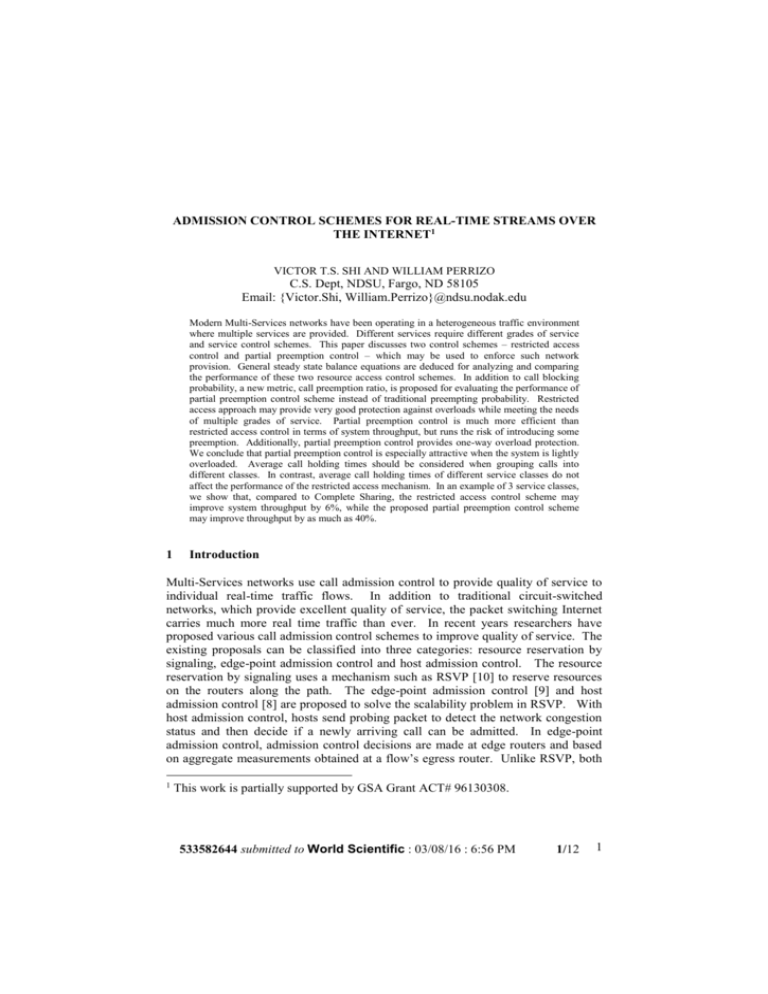
ADMISSION CONTROL SCHEMES FOR REAL-TIME STREAMS OVER
THE INTERNET1
VICTOR T.S. SHI AND WILLIAM PERRIZO
C.S. Dept, NDSU, Fargo, ND 58105
Email: {Victor.Shi, William.Perrizo}@ndsu.nodak.edu
Modern Multi-Services networks have been operating in a heterogeneous traffic environment
where multiple services are provided. Different services require different grades of service
and service control schemes. This paper discusses two control schemes – restricted access
control and partial preemption control – which may be used to enforce such network
provision. General steady state balance equations are deduced for analyzing and comparing
the performance of these two resource access control schemes. In addition to call blocking
probability, a new metric, call preemption ratio, is proposed for evaluating the performance of
partial preemption control scheme instead of traditional preempting probability. Restricted
access approach may provide very good protection against overloads while meeting the needs
of multiple grades of service. Partial preemption control is much more efficient than
restricted access control in terms of system throughput, but runs the risk of introducing some
preemption. Additionally, partial preemption control provides one-way overload protection.
We conclude that partial preemption control is especially attractive when the system is lightly
overloaded. Average call holding times should be considered when grouping calls into
different classes. In contrast, average call holding times of different service classes do not
affect the performance of the restricted access mechanism. In an example of 3 service classes,
we show that, compared to Complete Sharing, the restricted access control scheme may
improve system throughput by 6%, while the proposed partial preemption control scheme
may improve throughput by as much as 40%.
1
Introduction
Multi-Services networks use call admission control to provide quality of service to
individual real-time traffic flows. In addition to traditional circuit-switched
networks, which provide excellent quality of service, the packet switching Internet
carries much more real time traffic than ever. In recent years researchers have
proposed various call admission control schemes to improve quality of service. The
existing proposals can be classified into three categories: resource reservation by
signaling, edge-point admission control and host admission control. The resource
reservation by signaling uses a mechanism such as RSVP [10] to reserve resources
on the routers along the path. The edge-point admission control [9] and host
admission control [8] are proposed to solve the scalability problem in RSVP. With
host admission control, hosts send probing packet to detect the network congestion
status and then decide if a newly arriving call can be admitted. In edge-point
admission control, admission control decisions are made at edge routers and based
on aggregate measurements obtained at a flow’s egress router. Unlike RSVP, both
1
This work is partially supported by GSA Grant ACT# 96130308.
533582644 submitted to World Scientific : 03/08/16 : 6:56 PM
1/12
1
edge-point and host admission controls do not require routers to keep per-flow state
to ensure quality of service, thus they are scalable. The problems with edge-point
and host admission controls are long connection setup time and the bandwidth waste
caused by probing packets. Also the quality of service is not guaranteed because of
the traffic randomness. While current edge-point controls are measurement-based,
in this paper we assume that each ingress router has a virtual bandwidth capacity
and such capacity can be predicted by analyzing the measurement data. With the
assumed virtual capacity, the ingress router can perform admission control using
mathematical models. The advantages of ingress router control are much shorter
connection setup and no bandwidth waste (the virtual bandwidth capacity can be
deduced from data collected by passive traffic monitoring). Further, we assume
the calls can be classified into multiple classes and each class has its own QoS
requirements.
Under such an environment we analyze the performance
characteristics of priority admission control schemes – restricted access and
preemption control.
In the literature, several call admission control mechanisms have been proposed
and analyzed. The common goal has been to maintain acceptable quality of service
in an effective and efficient manner. Choudhury, Leung and Whitt [1] proposed
UL/GM (Upper-Limit/Guaranteed-Minimum) approach for the protection against
overloads in different classes of service. They concluded that UL/GM approach
outperformed CS (Complete Sharing), CP (Complete Partition) and TR (Trunk
Reservation) when asymmetric services are considered and fair protection against
overloads are needed (i.e., every class of service needs to be protected against
overloads in other classes of service). Biswas and Sengupta [2] studied CS, UL,
GM and TR approaches in a wireless ATM environment. They concluded that the
TR approach outperforms the others when different grades of service are needed. In
their experiments, the highest revenue gain could be up to 35% when using the TR
approach. Such a revenue gain might be a windfall to service providers. Rege and
Sengupta [3] considered multi-priority systems with three different service
disciplines: last-come first-served preemptive resume, multiple servers and
processor sharing. They further discussed three potential applications in the area of
computer and communication systems. Wang and Saadawi's [4] discussed the
applicability of trunk reservation techniques to nonhierarchical circuit-switched
networks in which two classes of traffic with unequal arrival rates and holding times
are present. They introduced two control schemes, restricted access and
preemption, to improve the overall performance. In their paper, steady-state
equations for two preemptive priority classes of calls were given and solved using a
method called successive over-relaxation (SOR)[5].
This paper studies restricted access and preemption control schemes in a single
link loss system with multi-class traffic (the link has the virtual bandwidth
capacity). In the restricted access scheme, a number of bandwidth units are
reserved to each class of service. A new service request is rejected if, after
accepting the request, the number of existing calls of that class is greater than the
533582644 submitted to World Scientific : 03/08/16 : 6:56 PM
2/12
2
threshold corresponding to that class of service. This is the so-called UL
mechanism mentioned in [1][2]. Restricted access control may still not be efficient,
though it outperforms the others in most situations as claimed in [1], because it is
possible that low priority calls are frequently rejected while certain bandwidth
resources are idle, in the hope of accepting high priority calls in the future. The
preemption control scheme is more attractive in this setting. Preemption control
allows low priority calls to use those bandwidths reserved for high priority calls,
and revokes the bandwidths when high priority call comes in. We studied a full
preemption control scheme in [6], where high priority calls preempt bandwidths
whenever low priority calls are in service. This paper studies a partial preemption
scheme, where preemption control is triggered only when the number of calls in low
priority classes of service simultaneously existing in the system reaches a
predefined threshold. The CS scheme [1][2] and the full preemption scheme [6],
may be considered as special control cases of our scheme, where the thresholds are
set to zero or the full capacity of the link, respectively.
Section 2 of this paper proposes a model for a link to which multiple classes of
calls arrive. Both the restricted access control scheme and the partial preemption
control scheme are considered. Section 3 further discusses the restricted access
control scheme and derives general forms of steady-state balance equations for
calculating the call blocking probability. A partial preemption control scheme is
proposed and equations for a link of K classes of traffic are given in section 4.
Call blocking probability is used as performance measure for the partial preemption
scheme. In addition, a new metric – call preemption ratio is proposed for measuring
the grade of service when preemption control is applied. Section 5 examines the
performance of the two control schemes through numerical experiments. Section 6
concludes the paper.
2
Models
In this section we propose a mathematical model for a single link loss system, i.e., a
newly arriving call is lost and cleared when it is not allowed to proceed due to lack
of resources. The link consists of n bandwidth units that correspond to n servers
in a random service system. All bandwidths are fully available to all calls. Calls
(corresponding to customers in a random service system) are classified into K
classes according to their priorities and denoted by T1 , T2 , …, TK . Their priority
levels are ordered in a decreasing way by convention, i.e., calls belonging to class i
have higher priority than calls belonging to class j if i j . The call arrival
process of the streams T1 , T2 , …, and TK are Poissonian with average rates 1 ,
2 , …, and K , respectively. The call holding times of the streams have negative
exponential distributions with means 11 , 21 , …, and K1 , respectively. All the
533582644 submitted to World Scientific : 03/08/16 : 6:56 PM
3/12
3
call arrival processes are independent of each other. Thus we denote the traffic
loads corresponding to Tk by ak where ak k / k for k 1,2,..., K .
We assume the switches at the ends of the link are non-blocking and the call
set-up times are negligible compared to the average call holding times. The
switches enforce the access control schemes by associating numbers n1 , n2 , …,
nK with classes T1 , T2 , …, TK , respectively. In the restricted access control
scheme, a new arrival call of class i will be rejected if the number of bandwidth
units servicing calls from that class is equal to n ni . In the partial preemption
control scheme, a new arrival call of class i will be rejected if no idle bandwidth in
the link is available and the number of calls of class j in service is not greater than
n n j for all i j . Otherwise, it will preempt a unit of bandwidth used by one of
the calls of class j if class j is the class of lowest priority of those classes that
have calls in service at the moment the new call arrives. For simplicity, we assume
the preempted call of lower priority is lost and cleared.
Let ( j1 , j 2 , …, j K ) denote the state of the link in which there are j1 calls of
priority 1, j 2 calls of priority 2, ..., j K calls of priority K being serviced by the
Let P( j1 , j2 ,..., jk ) be the corresponding steady-state probability.
link.
equation
n n1 n n2
n nK
j1 0 j2 0
j K 0
...
n
and equation
n
control scheme. We set
3
P( j1 , j 2 ,..., j K ) 1 holds for the restricted access scheme
n
... P( j1 , j2 ,..., j K ) 1
j1 0 j2 0
Then
holds for the partial preemption
j K 0
n1 to zero for efficiency and comparison reasons.
Restricted access control
With the model set in section 2 for restricted access, the state transitions form
Markov chains. The state space is jk N nk for k 1,2,... K . Applying the
conservative law we deduce steady state balance equations for general K classes of
traffic as follows:
K
( j k a k ) k P ( j1 , j 2 ,..., j K )
k 1
K
k 1
a k k P ( j1 , j 2 ,..., jk 1,..., j K )
K
(3.1)
( jk 1) k P ( j1 , j2 ,..., jk 1,..., j3 )
k 1
533582644 submitted to World Scientific : 03/08/16 : 6:56 PM
4/12
4
K
(
jk n , jk n nk for k 2,3,..., K )
k 1
with boundary conditions
K
jk k P( j1 , j2 ,..., j K )
k 1
K
ak k P( j1, j2 ,..., jk 1,..., jK )
(3.2)
k 1
K
(
jk n and jk n nk for k 2,3,..., K )
k 1
for m 1,2,..., K 1
K
ak k P( j1 , j2 ,..., j K )
k 1, 2,..., K
k ki ,i 1, 2,..., m
K
(3.3)
K
ak k P( j1 , j2 ,..., jk 1,..., jK )
k 1
K
(
jk k P( j1 , j2 ,..., j K )
k 1
k 1
( jk 1) k P( j1 , j2 ,..., jk 1,..., j3 )
k 1
jk n ; jki n nki r ,, ki 2,3,..., K , for, i 1,2,..., m ; j k n nk r
for k 2,3,..., K and k ki ,)
Let Pb(k ) be the call blocking probability for calls of class
Pb(1)
P( j1 , j 2 ,..., j K )
k . Then
(3.4)
j1 j2 ... jK n
Pb(k )
P( j1 , j 2 ,..., j K )
j1 j2 ... jK n
P( j1 , j 2 ,..., j K ) when
jk n nk
j1 j2 ... jK n
k 2,3,..., K (3.5)
4
Partial preemption control
Similarly, with the model described in section 2, we have general steady state
balance equations for the partial preemption control scheme as follows:
533582644 submitted to World Scientific : 03/08/16 : 6:56 PM
5/12
5
K
( j k a k ) k P ( j1 , j 2 ,..., j K )
k 1
K
(4.1)
K
ak k P( j1 , j2 ,..., jk 1,..., jK )
k 1
( jk 1) k P ( j1 , j2 ,..., jk 1,..., j3 )
k 1
K
jk n )
ak k P( j1, j2 ,..., jk 1,..., jK )
(4.2)
(
k 1
with boundary conditions
t 1
(
K
ak k
k 1
jk k ) P( j1 , j2 ,..., j K )
k 1
K
(
K
k 1
jk n , and jt n nt , t {1,2,..., K} , and ji n ni when t i K )
k 1
t 1
(
k 1
K
ak k
K
j k k ) P( j1 , j 2 ,..., j K )
k 1
a k k P( j1 , j 2 ,..., j k 1,..., j K )
k 1
i 1
ai i P( j1 , j2 ,..., jl 1,..., ji 1,... j K )
iE
l 1
(4.3)
K
(
jk n ,
jt n nt , t {1,2,..., K} ,
ji n ni , i Q {t 1, t 2,..., K} ;
k 1
ji n ni while i E , E Q {t 1, t 2,..., K} )
The call blocking probabilities are:
Pb(1)
P( j1 , j 2 ,..., j K )
(4.4)
j1 j2 ... jK n
jk n nk ,k 2,3,..., K
Pb(k )
P( j1 , j 2 ,..., j K ) when k 2,3,...,K 1
(4.5)
j1 j2 ... jK n
jt n nt ,t k 1,k 2,..., K
Pb( K )
P( j1 , j 2 ,..., j K )
(4.6)
j1 j2 ... jK n
533582644 submitted to World Scientific : 03/08/16 : 6:56 PM
6/12
6
Let Pr e(k ) be the preempting probability for class
Pr e(2)
k , then
P( j1 , j2 ,..., j K ) (4.7)
j1 j2 ... jK n
j2 nn2
jt nnt ,t 3, 4,..., K
Pr e(k )
P( j1 , j2 ,..., j K ) , k 3,4,..., K
(4.8)
j1 j2 ... jK n
jk nnk
jt nnt ,t k 1,k 2,..., K
Pr e( K )
P( j1 , j2 ,..., j K )
(4.9)
j1 j2 ... jK n
j K n nK
Customers of low priorities may feel it’s not acceptable if the probability of their
calls being preempted exceeds a certain threshold. Preempting probability Pr e(k )
tells us the probability that a unit bandwidth servicing a call of class k is
preempted when calls of higher priority arrive. No bandwidths will be preempted if
no calls of higher priority arrive. Thus the number of calls of class k being
preempted is related to Pr e(k ) and the arrival rates of higher priority calls. In [6],
we found that preempting probability may mislead us in the performance evaluation
of a preemption control scheme. Hence in this paper we use call preemption ratio as
the performance indicator. Let Pr et (k ) denote the call preemption ratio. We
define the call preemption ratio as the ratio of the number of calls being preempted
to the number of calls being accepted. That is
Pr et (2)
k 1
Pr et (k )
i 1
1 Pr e(2)
a11 Pr e(2)
2 [1 Pb(2)] a2 2 [1 Pb(2)]
k 1
i Pr e(k )
k [1 Pb(k )]
(4.10)
ai i Pr e(k )
i 1
ak k [1 Pb(k )]
when k 3,4,..., K
533582644 submitted to World Scientific : 03/08/16 : 6:56 PM
(4.11)
7/12
7
5
Experimental results
In this section we examine the numerical results of experiments with a variety of
traffic patterns and system configurations. Assume the link has 30 bandwidth units
( n 30 ) and calls are divided into 3 classes. n2 and n3 are set to 18 and 20
respectively. Table 1 lists 2 groups of experimental results with the restricted
access control scheme. It demonstrates that call holding time does not have impact
on the performance at all. Keeping this in mind, we may group the calls into
different classes without considering their holding time characteristic. Table 2
presents 2 groups of experimental results involving the partial preemption control
scheme. In contrast, we see that average call holding times greatly affects the call
blocking probabilities of each class. Assigning higher priorities to calls of longer
average holding time may reduce the blocking probability.
Table 3 demonstrates the impact of average holding times on call preemption
ratios. As defined in section 4, the call preemption ratio is a performance metric for
measuring the frequency of preemption in those calls which are accepted. Table 3
tells us that assigning to calls of longer average time, a higher priority, may greatly
reduce the number of unfinished calls (calls which are accepted but preempted by
calls of higher priority).
From results in tables 1, 2 and 3, we conclude that the partial preemption scheme
provides much better service in terms of blocking probability performance. With a
load of 6 Erlangs in each class, the preemption control scheme services all
customers with a blocking probability less than 0.003, whereas restricted access
services calls of class 3 with a blocking probability near 0.04, about ten times
greater than 0.003. The worst preemption ratios are near 0.00061 (with
1 0.1, 2 0.4, 3 0.8 ), a value that might be considered acceptable. If we
Pb(1) 0.0012 , Pb(2) 0.0121 ,
Pb(3) 0.044 and 1 0.1 , 2 0.4 , 3 0.8 , then the restricted access
approach provides a throughput of 18 Erlangs, the partial preemption control
approach, 21.6 Erlangs at the expense of Pr et(2) 0.000068 and
Pr et(3) 0.005375 with n2 18 and n3 20 . Compared to the CS approach
18 17
(throughput of 17 Erlangs), the throughput gains are
=5.9% and
17
21 .6 17
=27%, respectively.
If we consider
Pr et (2) 0.0022 and
17
Pr et(3) 0.0101 as acceptable, then the gain of the partial preemption control
23 .9 17
approach will be up to
=40.6% with n2 23 and n3 18 .
17
Longer average holding times result from higher blocking probabilities in the
preemption approach. This cause and effect does not occur in the restricted access
assume that the design parameters are
533582644 submitted to World Scientific : 03/08/16 : 6:56 PM
8/12
8
approach. We attribute this phenomenon to the increased average arrival rates of
calls and the fact that partial preemption allows more calls of low priority to exist
simultaneously.
The negative effect of allowing more low priority calls
simultaneously in the link can also been seen in Pb(1) columns in table 1 and 2,
where Pb(1) is slightly larger in table 2 than in table 1. More calls of classes 2 and
3 simultaneously existing in the system makes the blocking probability a little
higher for calls of class 1.
Table 1: Blocking probability with restricted access control scheme
( N 30, n2 18, n3 20 )
1 0.8, 2 0.4, 3 0.1
a1
a2
a3
5
6
7
8
9
10
1 0.1, 2 0.4, 3 0.8
Pb(1)
Pb(2)
Pb(3)
Pb(1)
Pb(2)
Pb(3)
0.000098
0.001208
0.006677
0.021487
0.048043
0.084404
0.003506
0.012099
0.030768
0.062069
0.104369
0.153054
0.018432
0.043658
0.081235
0.128657
0.181639
0.235715
0.000098
0.001208
0.006677
0.021487
0.048043
0.084404
0.003506
0.012099
0.030768
0.062069
0.104369
0.153054
0.018432
0.043658
0.081235
0.128657
0.181639
0.235715
Table 2: Blocking probability with partial preemption control scheme
( N 30, n2 18, n3 20 )
1 0.8, 2 0.4, 3 0.1
a1
a2
a3
5
6
7
8
9
10
1 0.1, 2 0.4, 3 0.8
Pb(1)
Pb(2)
Pb(3)
Pb(1)
Pb(2)
Pb(3)
0.000121
0.001496
0.008040
0.024711
0.052910
0.089950
0.000149
0.001812
0.009578
0.028962
0.061033
0.102204
0.000210
0.002375
0.011707
0.033494
0.067911
0.110829
0.000106
0.001310
0.007194
0.022778
0.049966
0.086275
0.000139
0.001713
0.009344
0.029335
0.063664
0.108586
0.000224
0.002686
0.014233
0.043119
0.089957
0.147453
533582644 submitted to World Scientific : 03/08/16 : 6:56 PM
9/12
9
Table 3: Preemption ratio with partial preemption control scheme
( N 30, n2 18, n3 20 )
1 0.8, 2 0.4, 3 0.1
1 0.1, 2 0.4, 3 0.8
a1 a2 a3
Pr et (2)
Pr et (3)
Pr et (2)
Pr et (3)
5
6
7
8
9
10
0.000057
0.000635
0.003107
0.008757
0.017304
0.027299
0.000726
0.006761
0.025845
0.056266
0.088541
0.116389
0.000008
0.000101
0.000543
0.001689
0.003657
0.006257
0.000053
0.000610
0.003100
0.009003
0.018058
0.028494
Overload protection is an important issue brought up in [1]. It is desirable that
overloads, caused by some classes of customers, do not grossly affect the system
service behavior offered to other classes of customers who stick to their contracts.
Our performance study shows that the partial preemption approach favors high
priority customers. The blocking probabilities increase much more sharply for
those calls of lower priority than for those calls of higher priority. An interesting
and positive phenomenon is that the call preemption ratios increase very slowly.
This means that overload in a particular class does not affect preempting behavior
significantly, even if the calls are of lower priority. We omit the performance study
of overload protection because of space limit. Please see [14] for detailed analysis.
6
Conclusions
Modern Multi-Services networks operate in a heterogeneous traffic environment. It
is reasonable that different services and customers may require different grades of
service. In addition, calls requesting larger bandwidth experience poorer service in
terms of call blocking probability, unless appropriate resource access control
schemes are adopted [7]. We used a simple model to provide some insights to the
performance of restricted access control and partial preemption control schemes.
Call blocking probability is used to evaluate the performance of the two access
control schemes. Moreover, we defined a new metric, call preemption ratio, to
evaluate preemption control instead of preempting probability – a traditional metric
used in [4][6]. The proposed call preemption ratio explicitly indicates the portion of
calls, which are accepted but not finished because of preemption. In an example of
a link with 3 classes of traffic, we found that average call holding times had no
effect on system performance when adopting restricted access control. In contrast,
we must take average call holding times into consideration for grouping classes of
traffic when adopting partial preemption control.
533582644 submitted to World Scientific : 03/08/16 : 6:56 PM
10/12 10
With proper thresholds, restricted access control may provide different grades of
service and certain degrees of overload protection, at the expense of certain amounts
of throughput loss. Preemption control discussed in [6] allows full access to
resources for all classes of traffic, providing a much more efficient way to use the
link resource at the expense of introducing possible preemption. Obviously it may
not be tolerable when the portion of calls being preempted exceeds a certain
threshold. While preemption control mechanisms do not provide a way to limit this
portion within certain threshold, the partial preemption control proposed in this
paper helps limit this portion in an efficient manner (see [14]). It also provides
one-way protection against overloads (traffic volume of lower priority has little
effect on calls of higher priority).
An attractive application of partial preemption control might be the situations
where light overload occurs. Partial preemption control greatly reduces blocking
probabilities to calls of low priority while preemption ratio keeps extremely low
(see tables 1, 2 and 3). Thus it significantly outperforms restricted access control
scheme in terms of system throughput. With the partial preemption approach,
preemption only occurs when the number of calls of low priority existing in the
system exceeds a certain threshold. This should be considered acceptable if the
maximum number of simultaneously supported calls of that class is limited, as is the
case with the restricted access control scheme.
A major concern with preemption policy is the damage caused by preemption.
First such damage can be limited by setting a low threshold of preemption ratio,
which represents the very low risk of a call being interrupted.
Second, the
implementation of preemption policies in practice may not result in interrupted
calls. We may temporary steal bandwidth by selectively dropping cells (packets)
from existing calls instead of interrupting a call. The temporary degradation of QoS
may be negligible since preemption is a rare event. Such “bandwidth stealing”
implementation is especially promising in the Internet. For example, a customer
(e.g., a university or a company) may purchase a certain amount of bandwidth from
an Internet Service Provider (ISP) for Internet access. The customer can use a
“bandwidth broker” [19] to enforce the QoS of real time streams. Then the
temporary “out of bandwidth” packets caused by preemption can be marked by the
egress router of the customer network by resetting the “A” bit (for assured service)
or “P” bit (for premium service) [12]. Such packets are treated as “best effort”
packets and may be dropped by the ISP network. Further discussion on admission
control for Internet QoS can be found in [8, 9, 13].
The concept of soft services has been introduced in recent years (e.g.,
Controlled-Load [11]) for packet switching Internet applications. Soft services do
not require guaranteed QoS to individual application flow. Instead, the QoS is
assured at a reasonable level by applying certain admission control to bound the
traffic load in the network. Partial preemption scheme has the risk of preemption to
low priority traffic, but it provides excellent protection against overload caused by
533582644 submitted to World Scientific : 03/08/16 : 6:56 PM
11/12 11
low priority traffic. Thus partial preemption may serve the need of soft services in
the Internet while producing excellent overload protection.
References
1. G. L. Choudhury, K. K. Leung and W. Whitt, “Efficiently providing multiple
grades of service with protection against overloads in shared resources”, AT&T
Technical Journal, pp.50-63, July-August, 1995
2. S. K. Biswas and B Sengupta, “Call admissibility for multirate traffic in
wireless ATM networks”, Infocom’97, 1997.
3. Rege and Sengupta, “A priority-based admission scheme for a multiclass
queueing system”, AT&T Technical Journal, Vol.64, No.7, pp.1731-1753,
1985.
4. W. Wang and T. N. Saadawi, “Trunk congestion control in heterogeneous
circuit switched networks”, IEEE Transations on Communications, Vol.COM40, No.7, p1156-1161, 1992.
5. R. Cooper, Introduction to Queuing Theory, 2nd ed., New York, Macmillan
Co., 1981.
6. V. T.-S Shi, C. Wang and W. Perrizo, “The performance of a link with
multipriority traffic”, IEEE Transactions on Communications, Vol. 46, No. 6,
pp.743-746, 1998.
7. B. Kraimeche and M. Schwartz, “Circuits access control strategies in integrated
digital networks,” Proc. IEEE Infocom’84, pp.230-235, 1984.
8. L Breslau, E. Knightly, S. Shenker, I. Stoica and H. Zhang, “Endpoint
Admission Control: Architectual issues and Performance”, ACM SIGCOMM
2000, pp.57-69.
9. C. Cetinkaya and E. Knightly, “Egress Admission Control”, IEEE INFOCOM
2000.
10. L. Zhang, S. Deering, D. Estrin, S. Shenker and D. Zappala, “RSVP: A new
resource ReSerVation Protocol”, IEEE Network, Vol. 7, No.5, pp.8-18, Sept.
1993.
11. J. Wroclawski, “Specification of the controlled-load network element service”,
1997, Internet Draft.
12. X. Xiao and L. Ni, “Internet QoS: A Big Picture”, IEEE network, No.2, 1999,
pp.8-18.
13. E. Knightly and N. Shroff, “Admission Control for Statistical QoS: Theory and
Practice”, network, No.2, 1999, pp.8-18.
14. V. Shi and W. Perrizo, “Acess control schemes and performance of a link with
heterogeneous traffic”, technical report, NDSU-CS-TR-06, 1999.
533582644 submitted to World Scientific : 03/08/16 : 6:56 PM
12/12 12
